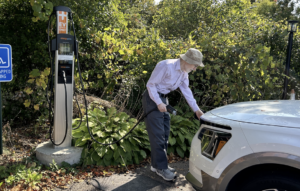This is part of a collection of case studies that focus on creative charging solutions for EV drivers in multifamily housing. For more information and the full collection, visit our Charging Solutions for EV Drivers in Multifamily Housing hub.
Challenge
Electric vehicles can lower transportation costs and save consumers money. Still, if you live in multifamily housing and don’t have access to home charging, these benefits may be diminished by the higher cost of using public chargers. How can these EV drivers access convenient and low-cost charging options?
Objectives and solutions
The State of Vermont developed a program to subsidize charging at multifamily housing across the state. Charge Vermont is funded by the state and administered by Vermont’s largest electric utility. Essentially, this program provides free (or almost free) installation of Level 1 and Level 2 chargers in multifamily housing. It offers up to 90% of the total project cost for market-rate housing installations and up to 95% of the total project cost for projects with a minimum of 50% affordable housing units. Federal, state, and utility incentives can all be used as a match. The program was initially funded by state appropriations but is now funded by EV registration fees. 
Vermont is considered the most rural state in the U.S., with almost 65% of its population living in rural areas. About 23% of Vermont’s housing is multifamily, and because Vermont is so rural, multifamily housing, including manufactured home parks, isn’t necessarily located in cities. Many Vermonters living in multifamily housing still have long commutes. Beginning in 2022, the Vermont Department of Housing and Community Development recognized a need for affordable and convenient home charging access for drivers living in multifamily housing. It developed a $1 million pilot to test how EV charging solutions could work for multi-unit property owners and residents. The pilot used grant recipient interviews, cost assessments, station use reporting and analysis, and case studies to develop best practices. The pilot has increased EV charging access to residents in 28 multifamily properties, with a total of 78 charging ports contracted. More recently, the VT Legislature passed a bill appropriating $7 million for the Charge VT program based on the learnings of the pilot.
One program requirement is to ensure that charging is distributed throughout the state, so no county can receive more than 10% of the available funding. Currently, counties with more urban areas are fully subscribed, but funding is still available in counties with more rural areas. Property managers interested in participating can fill out a simple online application form and participate in a pre-screening call. Charging equipment installers can be selected by the property manager or from a list of installation partners provided through the program. The equipment must be maintained for at least five years and must be networked equipment if the chargers are available to the general public. Equipment does not have to be networked if charging is restricted to residents only, which may keep costs lower for home charging.
Another unique and important feature of the program is that, through a partnership with Green Mountain Power, the state’s largest electric utility and program administrator, building owners can access a significant portion of the funding incentives before they start work. This is critical for smaller property owners who don’t have easy access to capital and can make it financially feasible for them to move forward with charging projects.
In 2024, the State Legislature passed a bill imposing additional registration fees on EVs. Unlike most states that use EV fees for road maintenance, Vermont is using these fees to fund this program, thus expanding access to charging for residents of multifamily housing.
Elements for Success
- Incentives can be stacked with utility programs, which are widely available in other states, and federal tax credits, making charger installations inexpensive or free.
- The program leverages a utility partnership to offer the bulk of the incentive before construction begins, covering the upfront investment that often deters property managers from installing EV chargers.
References
- Charge Vermont EV Chargers for Multi-unit Residences
- Multi-unit EV Charging Incentive Program
- Affordable Homes with Equitable Access to Transportation Options
Recap
Charger type: Level 1 or Level 2
Public or private
Problem addressed: Access, cost
Solution type: Policy